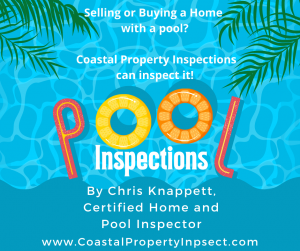Does the home you’re buying or you own have a pool? Get an Orange County Pool Inspection by Coastal Property Inspections!
Pool & Spa Inspection Checklist
A Pool Inspection:
To have adequate and functional water flow through the pool system, there are several things that need to be in good shape:
- There has to be enough water in the pool or spa. Check the level of the water.
- There shouldn’t be any water leaks at the plumbing connections or equipment.
- All of the valves should be fully open.
- There shouldn’t be any trapped air in the system. Air at the filter tank should be purged routinely.
- The skimmer and main drain should be clear of blockages and debris. Skimmers require cleaning.
- The strainer pot at the pump should be cleaned routinely.
- There might be an imbalance of the water chemistry, causing scaling. Check for scale-causing clogging or restriction of water flow.
- The heater should be on and activated. The gas shut-off valve should be open. The switch should be on. Check for a pilot light, ignition, or flame at the fuel-fired heater. Check the level in the propane storage tank.
- The thermostat should be connected, active, and set properly.
The following pool inspection checklist was adapted from the guidelines recommended by the National Swimming Pool Foundation (NSPF). Use the checklist as a starting point in developing your own checklist that fits your inspection procedure and needs.
The inspector should check for the following when doing a pool inspection:
- Adequate fencing, gates, barriers, alarms, and/or other protective devices are installed.
- Adequate storage space is provided for equipment.
- Decks around pool are not cluttered.
- The pool is covered when not in use.
- Surfaces leading to the pool, including the deck and steps, are slip-resistant.
- Decks on all sides of the pool meet minimum safety standards.
- The deck is separated from the pool wall perimeter.
- There are no standing puddles on the deck.
- All ladders, stanchions, chairs, and rails have treads with a contrasting color coating or tile on both the top and vertical rise.
- No unpleasant odors or irritating fumes are apparent.
- No physical damage is apparent at the pool equipment.
- Main drain grates are bolted securely to the pool’s bottom.
- Grates are visible from the deck, with no apparent damage.
- Drain covers are installed.
- Water return inlets are installed
- The pool is vacuumed daily.
- No debris is visible. The water is clean.
- There’s no discoloration of the water.
- There is no visible algae growth.
- The pool water is tested at the frequency required or desired.
- All water quality and chemical levels were within acceptable ranges as of the most current test.
- Bacteriological water analysis is performed on a regular basis.
- The water temperature is maintained within acceptable levels and is appropriate for the primary activities being conducted in the pool.
- The water temperature has been measured and recorded.
- The type of heater is identified.
- The efficiency and BTU ratings of the heater are identified.
- The heater is installed on a level, non-combustible base.
- Safety devices are installed on the heater.
- The thermostat is located and identified.
- Check valves between the heater and filter are installed.
- Bonding and grounding are visible.
- The heater is installed downstream of the pump and filter.
- A solar-heating system is installed.
- The solar-heating system type is identified.
- The solar-heating system is active.
- Pool chemicals are stored a safe distance away from the heater.
- Adequate clearances around the heater are maintained.
- Coping stones and tiles are not chipped, cracked or loose.
- The pool shell appears smooth, without readily visible defects.
- There is no visible surface staining.
- The water level appears to be maintained to allow for the removal of floating debris.
- The water level appears at the proper height to allow continuous overflow of water into the gutters or skimmers.
- Skimmer weirs, skimmer baskets, deck covers, and flow-adjustment devices are installed.
- Lights are installed and are operational.
- The type, number and wattage of deck lighting are identified.
- The number of underwater lights is noted.
- GFCIs are installed.
- Electrical wiring is not passing directly over the pool or spa.
- Hose bibs are installed near the pool.
- No apparent defects or signs of repair are observed at the diving board.
- The manufacturer of the diving board is visible on the board itself.
- The centrifugal pump is secured to its base and is operating quietly.
- The hair and lint strainer basket is clean of debris.
- The type of pipe has been identified.
- Pipes and fittings are not leaking.
- Pipes are supported adequately.
- Pipes are not showing signs of calcification, corrosion or deterioration.
- Air pressure-relief valves are installed on all pressure filter tanks.
- Filter tanks are accessible.
- The filter’s brand is identified.
- A clean sight glass or visual outfall of at least 3 feet has been provided.
- The pressurized filter tanks and hair and lint traps are not leaking and are properly sealed.
- All piping, filters and components that are part of the system are labeled, tagged, color-coded, or otherwise identified.
- A spa is installed.
- The spa is operational.
- A spa cover is installed.
- No physical damage is apparent at the spa.
- A spa timer is installed and not reachable by a spa user.
- The emergency shut-off switch for the spa is installed and clearly labeled.
- The spa appears clean and adequately maintained.
Pool Inspection: California 7 Safety Features
In some areas, such as California, there are certain pool features that home and pool inspectors are required to inspect. Those features are listed below. In California, the swimming pool or spa must be equipped with at least two of the following seven drowning-prevention safety features:
- an enclosure that isolates the swimming pool or spa from the private single-family home;
- removable mesh fencing that meets American Society for Testing and Materials (ASTM) Specification F2286 standards in conjunction with a gate that is self-closing and self-latching and can accommodate a key-lockable device;
- an approved safety pool cover;
- exit alarms on the private single-family home’s doors that provide direct access to the swimming pool or spa. The exit alarm may cause either an alarm noise or a verbal warning, such as a repeating notification that “the door to the pool is open”;
- a self-closing, self-latching device with a release mechanism placed no lower than 54 inches above the floor on the private single-family home’s doors, providing direct access to the swimming pool or spa;
- An alarm that, when placed in a swimming pool or spa, will sound upon detection of accidental or unauthorized entrance into the water. The alarm shall meet and be independently certified to the ASTM Standard F2208 “Standard Safety Specification for Residential Pool Alarms,” which includes surface motion, pressure, sonar, laser, and infrared type alarms. A swimming protection alarm feature designed for individual use, including an alarm feature designed for individual use, including an alarm attached to a child that sounds when the child exceeds a certain distance or becomes submerged in water, is not a qualifying drowning prevention safety feature; and
- other means of protection, if the degree of protection afforded is equal to or greater than that afforded by any of the features set forth above and has been independently verified by an approved testing laboratory as meeting standards for those features established by the ASTM or the American Society of Mechanical Engineers (ASME).
To see what is included in a full, comprehensive home inspection CLICK HERE.

